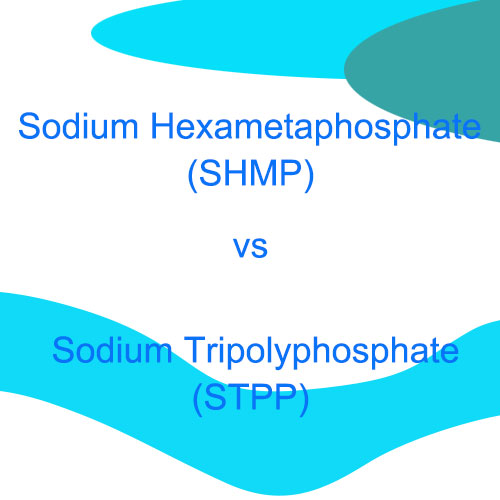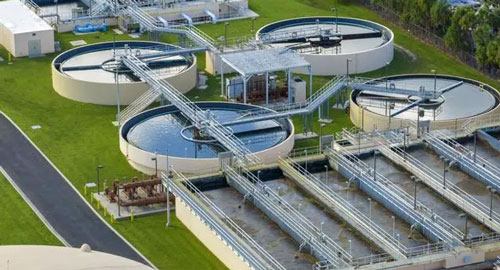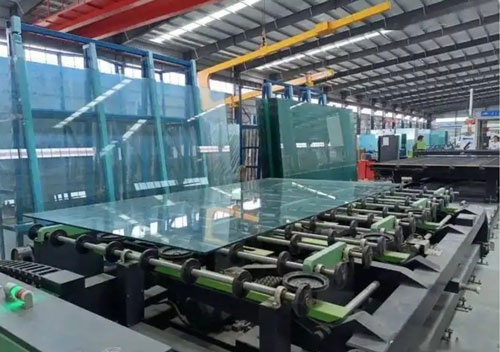Both sodium hexametaphosphate and sodium tripolyphosphate are so widely used that they overlap in many industries. For example, they are found in the food, ceramics, concrete, glass, and refractory industries.

There are times when they are used individually, and there are times when the two need to be mixed and used together.
Especially when they need to be mixed, it is easy to be confused about the ratio of their use.
This paper compares their specific functions and provides mixing ratios as a reference when mixing them. In addition to their functional perspective for the choice of the two ratios to provide an idea. On the one hand, it can deepen your understanding of them, and on the other hand, it can provide a reference for ratio selection.
I. Food industry
A. Meat products

Sodium tripolyphosphate in food grade can enhance the hydration and water retention of meat products, improve the quality and flavor of food.
Food grade sodium hexametaphosphate can improve the water retention and adhesion of meat products, slow down the oxidative rancidity of fat, improve the organization of meat products, maintain the nutrients and tenderness of meat, and improve the texture and taste of meat products.
They are used in combination with sodium pyrophosphate, which can expand the scope of action of a single phosphate to achieve the purpose of both reducing the amount of additives used and improving the flavor and taste of food.
Recommendations for mixing ratios
Generally, the mixing ratio of sodium hexametaphosphate and sodium tripolyphosphate is 1:1. This ratio is often used in food processing to improve water retention, texture and yield of food.
Specific usage amount of sodium hexametaphosphate and sodium tripolyphosphate in different foodstuffs, usually as following:
- Beef and rabbit: the best tenderizing effect on beef and rabbit is achieved when the addition amount of compound phosphate is 0.5%.
- Ham: the best use amount is 0.4%.
- Fish: the optimal use level is 0.5%.
- Chicken: the optimal phosphate ratio is 32.6% sodium hexametaphosphate and 45.6% sodium tripolyphosphate when obtaining the maximum yield.
B. Beverages

Sodium hexametaphosphate is mainly used to regulate acidity, increase viscosity and prevent gel precipitation. For example, in fruit drinks and refreshing drinks, it can improve juice yield, increase viscosity and inhibit vitamin C decomposition. In ice cream, it can improve expansion capacity, enhance emulsification, prevent paste destruction, and improve taste and color. In dairy products and beverages, it can prevent gel precipitation; in beer, it can clarify the liquor and prevent turbidity.
Sodium tripolyphosphate is mainly used for thickening and water retention. It makes beverages more stable and prevents sedimentation and stratification. However, the use of sodium tripolyphosphate in certain beverages is limited because it tends to decompose at high temperatures, under acidic or prolonged conditions, producing substances unfavorable to the human body.
It can be seen that sodium hexametaphosphate is suitable for beverages that require an acidic environment and viscosity, while sodium tripolyphosphate is suitable for beverages that require stability and water retention.
Recommendations for mixing ratios
Sodium hexametaphosphate and sodium tripolyphosphate are usually mixed at a ratio of 2:3 or 1:1. This ratio provides optimal emulsification and flavor stability, while also controlling metal ions, color and microorganisms, regulating pH and buffering, maintaining tenderness, and improving yield.
II. Water treatment

Both sodium hexametaphosphate and sodium tripolyphosphate can remove metal ions in water through chelating effect, so that are used in water softening.
Sodium hexametaphosphateIt: It is suitable for water quality treatment occasions that need to remove metal ions and acidic substances.
Sodium tripolyphosphate: It is suitable for occasions that need to reduce water hardness and detergent aids.
Recommendations for mixing ratios
The mixing ratio of sodium hexametaphosphate and sodium tripolyphosphate is usually between 1:1 and 1:2. This ratio can give full play to the synergistic effect of the two to improve the effect of water treatment. It can form a thin and dense anti-corrosion film, which is characterized by fast film formation, good film replenishment effect, low toxicity and no pollution.
III. Ceramic industry

Sodium hexametaphosphate:
It is mainly used in the preparation of ceramic glaze, which can improve the gloss and smoothness of the glaze, and also improve the suspension and fluidity of the glaze and reduce the precipitation of the glaze.
Due to its good dispersibility and suspension, sodium hexametaphosphate can provide better uniformity and stability in ceramic glaze, reduce the defects of glaze and improve the overall quality of the product.
Sodium Tripolyphosphate:
It is mainly used for the adjustment and suspension of glaze slurry, which can improve the stability and fluidity of glaze slurry and prevent glaze slurry from precipitation, thus ensuring the quality of ceramic products.
Its application in ceramic glaze paste can significantly improve the suspension and stability of the glaze paste, prevent the glaze paste from settling, and ensure the homogeneity and consistency of ceramic products.
Sodium hexametaphosphate and sodium tripolyphosphate are used in different process in ceramic producing, so they don’t mix using.
Sodium hexametaphosphate is usually mixed with other water reducing agents such as sodium polyacrylate and sodium citrate to further optimize the properties of ceramic materials.
IV. Concrete industry

Sodium tripolyphosphate:
It has obvious retardation effect in concrete, the reason is that sodium tripolyphosphate forms complex salts with calcium ions in solution, which reduces the concentration of calcium ions in solution and hinders the precipitation of calcium hydroxide crystals, and at the same time, the complex formed is adsorbed on the surface of cement particles, which inhibits the hydration of the cement, and thus achieves the purpose of retarding the setting. It can inhibit the hydration of cement and achieve the purpose of retardation.
In addition, sodium tripolyphosphate can also reduce the water-cement ratio of concrete, improve the strength and durability of concrete, while increasing the fluidity of concrete and reducing the degree of collapse.
Sodium hexametaphosphate:
It is mainly used as concrete retarder, which can increase the Z-potential between particles through physical adsorption, so as to improve the densification, mechanical properties and thermodynamic properties of castables. Improve the densification and mechanical properties of castables.
Specific application effects:
sodium tripolyphosphate is mainly used in concrete for retardation and improvement of concrete properties, while sodium hexametaphosphate is mainly used in retardation of concrete and improvement of densification and mechanical properties of castables.
Both of them are different in chemical properties, use effect and application scope, and the specific choice should be decided according to the project requirements.
Recommendations for mixing ratios
There is no specific standard ratio regarding the mixing ratio of sodium hexametaphosphate and sodium tripolyphosphate in concrete. The choice of mixing ratio should be based on the specific project requirements, type of concrete and performance requirements.
Generally speaking, sodium hexametaphosphate is mainly used for retardation and improvement of concrete performance, while sodium tripolyphosphate is more used for dispersing effect. In practical application, it can be adjusted according to the concrete proportion design to achieve the best construction performance and hardening performance.
V. Refractory materials

Sodium Hexametaphosphate:
It is mainly used as an acidic binding agent, it can react with calcium oxide and alumina in the refractory material to form a high hardness and a structure resistant to cold and thermal shocks, and enhance the creep and burst strength of the refractory material. The products produced have higher stability and can withstand higher temperature environment, which is suitable for high-grade refractories.
Sodium tripolyphosphate:
It is mainly used as alkaline binding agent, it reacts with oxides (such as alumina, magnesium oxide) in the refractory material to form a more stable structure and enhance the bonding force of the refractory material. However, its bonding performance for the complex structure of the oxide and some carbon-containing material effect is more general. The products produced have poor high-temperature resistance and are suitable for medium and low-grade refractories.
Recommended Mixing Ratio
Sodium hexametaphosphate and sodium tripolyphosphate are typically used in a 3:2 ratio, which provides good performance in most applications.
In some specific applications, adjustments may be necessary. For example, refractory materials used in high temperature environments may require an increase in the proportion of sodium hexametaphosphate to improve the high temperature resistance of the material. Whereas in scenarios where better flowability is required, the proportion of sodium tripolyphosphate may be increased appropriately.
VI. Glass manufacturing

Sodium Tripolyphosphate: In glass manufacturing, sodium tripolyphosphate is mainly used to improve the strength and transparency of glass. It improves the physical properties of glass, such as tensile strength and heat resistance.
Sodium Hexametaphosphate: In glass manufacturing, Sodium Hexametaphosphate is mainly used to improve the strength and transparency of glass. Due to its good crystallinity, it can significantly improve the strength and transparency of glass products, making them stronger and more beautiful.
Recommendations for mixing ratios
The mixing ratio of sodium hexametaphosphate and sodium tripolyphosphate is usually 1:1 in glass production. This mixing ratio helps to improve the melt properties and stability of the glass, reduce the generation of bubbles and streaks, and thus improve the quality of the glass. In addition to sodium hexametaphosphate and sodium tripolyphosphate, other fluxes such as sodium carbonate, lead oxide and zinc oxide are commonly used in glass production.
VII. Summary
In summary, sodium tripolyphosphate and sodium hexametaphosphate are used at the same time in many industries. Although they are both phosphates, their specific effects are different. In the process of use, the ratio of the two needs to be adjusted according to the requirements of the product and process, so as to achieve the best use effect.

